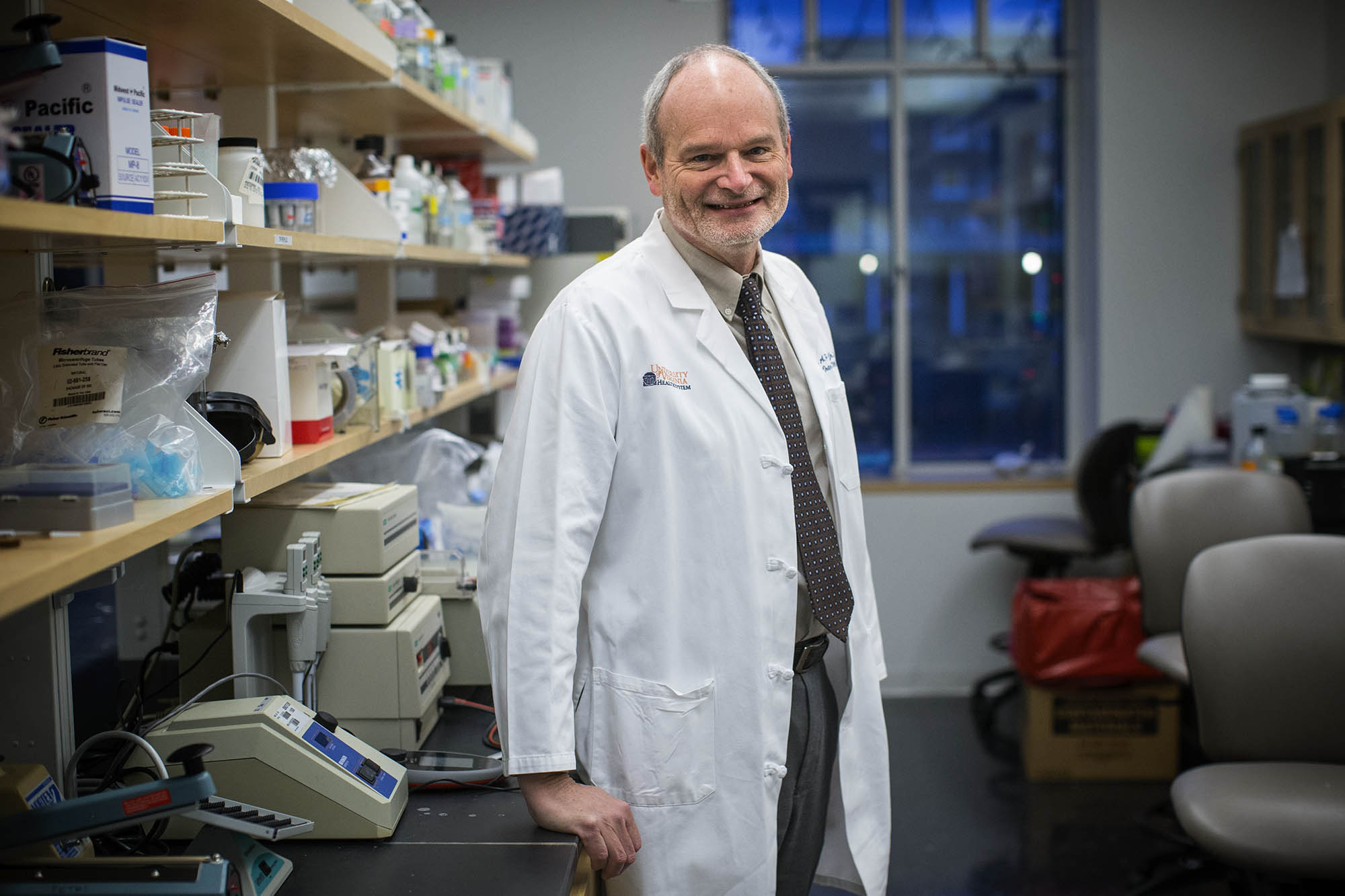COVID-19 cases are spiking in many areas of the United States. More than 4.4 million Americans have tested positive for the disease, and many millions more are likely to have been exposed or infected. More than 150,000 have died. Worldwide, 16.5 million people have tested positive, and more than 650,000 have died. The virus is not going away.
However, several new vaccines are entering Phase III clinical trials. And researchers worldwide, and at the University of Virginia, are seeking and identifying more effective treatments for the disease, as well as innovative vaccines designed to provide long-lasting protection. Meanwhile, standard preventive measures – mask-wearing, hand washing and physical distancing – are reducing disease transmission.
Dr. William Petri, a chaired professor of infectious diseases and international health at UVA and vice chair for research in the Department of Medicine, is studying the effects of the disease on the immune system, and seeking new treatments and vaccines.
Here he discusses COVID-19 for readers of UVA Today.
Q. What is the most striking thing you’ve learned about this disease?
A. The most striking thing is the extreme degree to which the immune system is activated in patients with severe COVID-19. In our lab we study many infectious diseases, including highly inflammatory ones, and they all pale compared to the immune activation with COVID-19 that Mary Young, a researcher in our lab, has observed. We’re testing a hypothesis that the immune system is actually making things worse when responding to this coronavirus.

We’ve learned through our work with researcher Allie Donlan in the Carter Immunology Center that a signaling molecule called Interleukin 13 – which can contribute to lung damage – is much more frequently elevated in people requiring mechanical ventilation than in people whose infection is less severe. In the mouse model of SARS-CoV-2 infection that infectious diseases professor Barb Mann has developed, neutralization of IL-13 is protective from COVID-19. Fortunately, therapies for turning off this part of the immune system already exist, and are approved for treating allergic lung disease. So, it could be a short path to a clinical trial specifically for treating the inflammation of COVID-19 by inhibiting or neutralizing Interleukin 13. We are continuing to explore this in our own lab.
Q. Why are some people affected very little by this infection, while others crash?
A. The No. 1 risk factor of this disease is age, and that’s independent of coexisting illnesses like lung disease or heart disease. The older you are, the more vulnerable you are. If you are 80 years old, you are 100 times more likely to die than somebody who’s 50. If you are 50, you are at somewhat greater risk than a 20-year-old. Every year beyond 50 increases your susceptibility, often determining whether you end up in the hospital or can recover at home. We don’t understand why that is. It’s possibly a difference in the way the immune system reacts to this virus as we age.
This virus is unique in that its receptor in our cells is ACE2 [Angiotensin-Converting Enzyme 2], a very important enzyme for maintaining normal blood pressure and for preventing inflammation and blood clots. This coronavirus binds to ACE2 and down-regulates it, increasing susceptibility to inflammation and clotting. That is one of the reasons COVID-19 inflammation is so dramatic.
People with preexisting illnesses, such as lung disease and diabetes, are more likely to have a severe negative outcome with this disease. And, the more exposure to the virus – the more virus in your nostrils and lungs – the more likelihood of a bad outcome.
Q. Do you see any younger patients who, for whatever reason, are in bad shape?
A. Yes, and that’s one reason we are trying to understand individual susceptibility to infection. Young people should take this infection seriously, mainly because they can serve as vectors to infect older people who are much more vulnerable. But younger people are vulnerable as well. Being young does not mean you have no risk of death; you just have a much lower risk, which is not zero.
We’re finding with this disease that some people suffer terribly, regardless of age, and others will have almost no symptoms. We’re trying to figure out why – how much of that is nature, and how much is the hard-wiring of your DNA that predisposed you to have a far worse outcome.
Q. What is our responsibility as individuals and as a society to bring this pandemic under control?
A. We’re all in this together. We’re responsible, and it’s a completely solvable problem. If everyone wore masks for a few weeks, we’d see a huge diminishment of infections. It’s an acute infection, and in almost everyone, the immune system does a great job of curing the infection. It’s not like HIV, where once you’re infected, you’re always infected. So, if we can stop transmission by wearing masks and maintaining some distance, this could nearly disappear in a few weeks.

Petri is studying the effects of COVID-19 on the immune system. (Photo by Sanjay Suchak, University Communications)
But if we’re irresponsible, it threatens everything. It threatens our economy and our ability to being students back to school. And just think how terrible you would feel if you gave the infection to someone else and they died. That actually is inadvertently happening when people gather in crowds and don’t wear masks.
Q. How important is testing for the virus?
A. The best way to control an epidemic is to identify the cases, isolate them, and then identify the contacts and have them quarantined for the incubation period, which is about 14 days.
Unfortunately, we can’t do that right now because of delays in testing and the overwhelming number of new COVID-19 cases – tens of thousands of new cases each day. What you ideally want is rapid tests of anybody who’s got symptoms – loss of taste or smell, fever, shortness of breath, diarrhea, even just a runny nose or muscle aches – so they can know whether they’re infected or not. If so, they can isolate themselves and their contacts could quarantine to stop the spread of infection.
But, again, the best way to stop transmission is to wear masks, wash our hands, and not form into large crowds. We need to all do these things to help each other break the chain of transmission.
Q. What have we learned from this pandemic, and are we ready for the next one?
A. There is continued risk for new pandemics. People in government and medical circles have been thinking about this for a long time and their foresight has helped us deal with this one. We’ve learned from this pandemic that you can stop international travel, and that sheltering in place works well to reduce transmission of infection. We’ve had to do that at incredible economic cost.
In vaccine science, we’re learning that there’s a certain amount of “plug-and-play” – that techniques used to develop a vaccine for one pathogen can often be applied to another. The reason we’re going to have a vaccine in 2021 is because of foresight, government funding for research, and innovations.
We will be better prepared for the next pandemic because of the lessons we’ve learned from the COVID-19 pandemic.
Q. Where do you think we’ll be in the next six months or so and over the next couple of years?
A. I think the current uptick in COVID-19 cases is going to trend down and come under control over the next several weeks because people are realizing what’s happening, and behaviors are starting to change. Use of facemasks, a common-sense intervention, is finally becoming much more accepted.
This upcoming cold and flu season is going to be complicated. COVID-19 and the flu have similar symptoms, such as coughs and shortness of breath. It could be flu, it could be coronavirus, it could be pneumonia, so we’re going to need rapid diagnostic tests to make distinctions because treatments are different.
I do think we’ll see a vaccine come out in 2021. The Moderna vaccine just entered Phase III clinical trials. And all five U.S. vaccines that are going into clinical trials are being mass-produced simultaneously. The ones that work will get nearly instantaneous FDA approval for distribution.
I think the first vaccinations should go to prisons and nursing homes, because those are the clusters where we’re seeing the biggest problems. Very quickly after that we should vaccinate first line responders, health care providers and immediately thereafter the general public. Universal immunization is the best thing, as we have learned from influenza, because if you immunize the grandchild, you’re protecting the grandparent.
Q. People’s immunity to this virus seems to fade rather quickly. Will a vaccine provide longer-lasting immunity?
A. I do think we will be able to solve the problem of the immune response to the coronavirus, which is that antibodies disappear within months after infection. In our lab at UVA, infectious diseases professor Mayuresh Abhyankar has come up with an immunization that provides a long-lived antibody response using a vaccine adjuvant that activates a part of the immune system called a toll receptor. This research suggests that we’ll have vaccines that provide long-lasting protection.
Media Contact
Article Information
July 29, 2020
/content/qa-dr-william-petri-covid-19-vaccines-and-pandemic

